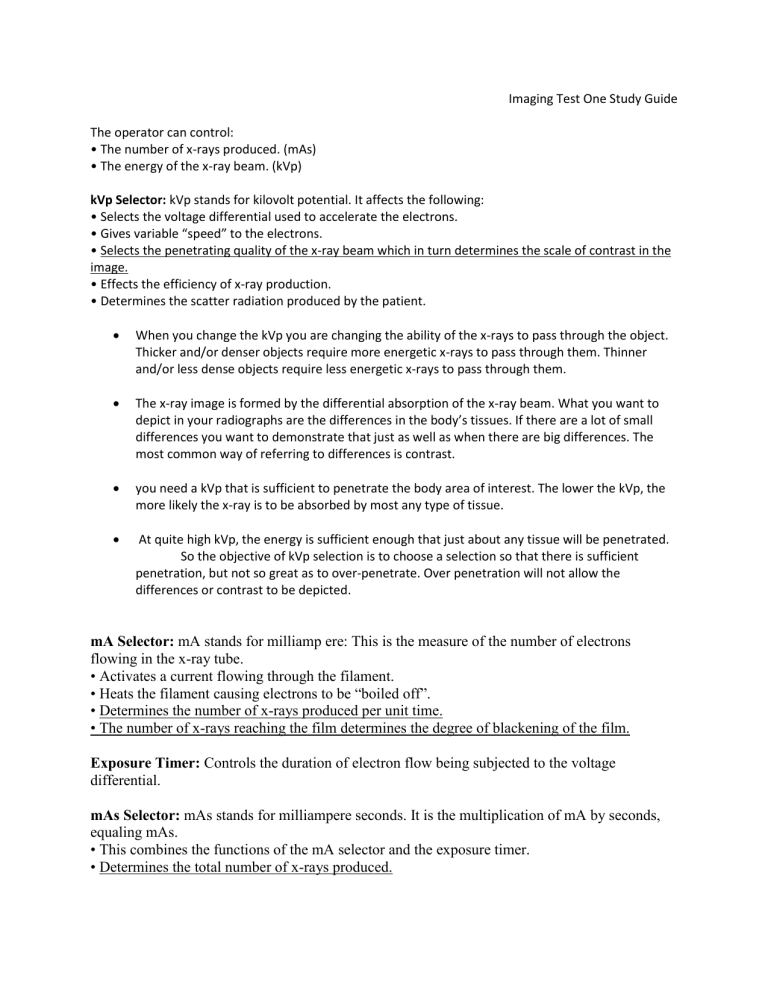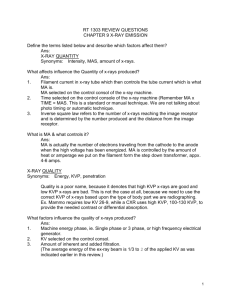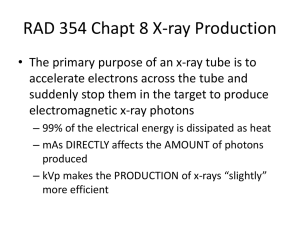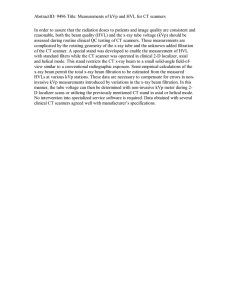
Imaging Test One Study Guide The operator can control: • The number of x-rays produced. (mAs) • The energy of the x-ray beam. (kVp) kVp Selector: kVp stands for kilovolt potential. It affects the following: • Selects the voltage differential used to accelerate the electrons. • Gives variable “speed” to the electrons. • Selects the penetrating quality of the x-ray beam which in turn determines the scale of contrast in the image. • Effects the efficiency of x-ray production. • Determines the scatter radiation produced by the patient. When you change the kVp you are changing the ability of the x-rays to pass through the object. Thicker and/or denser objects require more energetic x-rays to pass through them. Thinner and/or less dense objects require less energetic x-rays to pass through them. The x-ray image is formed by the differential absorption of the x-ray beam. What you want to depict in your radiographs are the differences in the body’s tissues. If there are a lot of small differences you want to demonstrate that just as well as when there are big differences. The most common way of referring to differences is contrast. you need a kVp that is sufficient to penetrate the body area of interest. The lower the kVp, the more likely the x-ray is to be absorbed by most any type of tissue. At quite high kVp, the energy is sufficient enough that just about any tissue will be penetrated. So the objective of kVp selection is to choose a selection so that there is sufficient penetration, but not so great as to over-penetrate. Over penetration will not allow the differences or contrast to be depicted. mA Selector: mA stands for milliamp ere: This is the measure of the number of electrons flowing in the x-ray tube. • Activates a current flowing through the filament. • Heats the filament causing electrons to be “boiled off”. • Determines the number of x-rays produced per unit time. • The number of x-rays reaching the film determines the degree of blackening of the film. Exposure Timer: Controls the duration of electron flow being subjected to the voltage differential. mAs Selector: mAs stands for milliampere seconds. It is the multiplication of mA by seconds, equaling mAs. • This combines the functions of the mA selector and the exposure timer. • Determines the total number of x-rays produced. When you change the mAs you change the number of x-rays produced. Film blackening is directly proportional to the number of x-rays that pass through the object, room air or patient tissue. Too much white = to little mAs, too much black = too high mAs. Summary: • kVp controls x-ray energy and thus penetrating ability and scale of contrast. • mAs controls the total number of x-rays produced and thus film blackening. • The most common failure of x-ray tubes is the result of technical error. To prevent costly damage to the x-ray tube it is important to use the appropriate kVp and mAs exposure selections to prevent damage to the anode. kVp gives variable “speed” to the electrons determining the penetration of the x-ray beam, which affects the efficiency of x-ray production, and determines the scale of contrast in the image. The mAs determines the number of x-rays produced per second and the number of x-rays reaching the film determines the degree of blackening of the film. Choosing the Appropriate Exposure Factors The type of tissue in the region of interest constitutes the subject contrast which is what you want to display. For example, you want to display the differences between different body systems the major way to depict these is in the selection of the kVp used to image the area of interest. The correct kVp will produce differential x-ray absorption of soft and dense anatomic structures. Increasing kVp increases the penetrating power of the x-ray beam. If kVp is too low, the image will lack density resulting in a whitewashed or sooty appearance. If kVp is too high the image will be over exposed and too dark. In small animals and in the distal extremity region of large animals where bone is the major structure of interest, a relatively low kVp (60-70) is sufficient to penetrate the bone and soft tissue. The low kVp will be very effectively absorbed by the bone mineral and provide good contrast. This level of kVp will provide a rather “contrasty” image which most find pleasing to use for bone evaluation. To provide the film blackening needed relatively high mAs will be needed. As always try to use the shortest time possible to prevent blurring from patient motion. In the thorax where there is a large variation in the types of tissue present, thin pulmonary vessels, thick volume of the heart, very minimally absorbing aerated portion of the lung, a relatively high kVp (80-100) is desirable to distinguish this variety of subject contrast. As these x-rays will be quite energetic, not as many are needed to establish the degree of blackening so a relatively low mAs is used. A short exposure time is essential in the thoracic region to stop the blur of respiration motion. Preferred Relative Exposures: • Skeletal – High mAs with low kVp • Abdomen – Medium mAs with medium kVp • Thorax – Low mAs with high kVp Overall Too Black – Causes & Corrections: Overexposure: Selection of too high mAs such that too many x-rays reach the film. Check the line on your technique chart to be sure that you read the correct mA an exposure times. Check the control panel to be sure that you selected the correct mA and exposure times. Inadvertent exposure of the film to light prior to and during development. Check that stored film is not exposed to stray light Exposure to stray x-radiation. Over Development: Light leakage reaching only a portion of the film (In film film too much developer chemical used, or for too long) Overall Too White – Causes & Corrections: Underexposure: Selection Of too low mAs such that too few x-rays reached the film. Check the line on your technique chart to be sure that you read the correct mA an exposure times. Check the control panel to be sure that you selected the correct mA and exposure times. Poor Image Contrast: Contrast refers to the visual difference between regions in the image. If there is no visual difference between areas there is no contrast. Poor image contrast may be due to pathological changes in the patient. It can also however be artificially created. Improper exposure setting, excessive scatter radiation reaching the film, fogged film, and poor processing can all result in poor contrast. Exposure Setting – Both over and under exposure produce less than optimal image contrast. Scatter Radiation Production – Most scatter radiation is produced by the patient. The larger the surface area of the patient exposed to the x-ray beam, the larger the amount of scatter radiation produced. The best way to reduce the production of scatter radiation is to limit the surface area irradiated. Collimation of the beam to only the part of interest makes a significant improvement in the image contrast. Whole body images should be avoided





